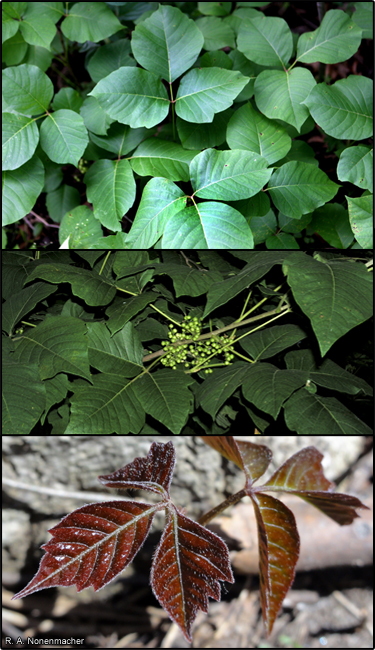Common poison ivy (Toxicodendron radicans)
 Description: All parts of this plant are highly toxic.
Description: All parts of this plant are highly toxic.Habit: Perennial shrub or woody vine that can reach a height of 3 ft. or 60 ft. long.
Leaves: Alternate, trifoliate, 7-10 in. long, leaflets are ovate and irregularly toothed, shiny green above and paler below.
Stems: Slender, gray to reddish-brown in color, sparingly pubescent or glabrous, older growth is densely covered and hairy.
Flowers: Dioecious, small, yellowish-green in color, appearing in clusters.
Fruit and seeds: Greenish white, round, 0.25 in. in diameter, borne in hanging clusters.
Habitat: Native to North America.
Reproduction: By seed or vegetatively.
Similar species: Atlantic poison oak (Toxicodendron pubescens), Pacific poison oak (Toxicodendron diversilobum), Skunkbush sumac (Rhus trilobata), Fragrant sumac (Rhus aromatica).
Credits: The information provided in this factsheet was gathered from the Virginia Tech Dept. of Forest Resources and Environmental Conservation.
Individual species images that appear with a number in a black box are courtesy of the Bugwood.org network (http://www.invasive.org). Individual photo author credits may not be included due to the small display size of the images and subsequent difficulty of reading the provided text. All other images appear courtesy of Google (http://images.google.com).
Common Name: | Common poison ivy |
Scientific Name: | Toxicodendron radicans |
Family: | Anacardiaceae (Sumac) |
Duration: | Perennial |
Habit: | Vines |
USDA Symbol: | TORA2 |
